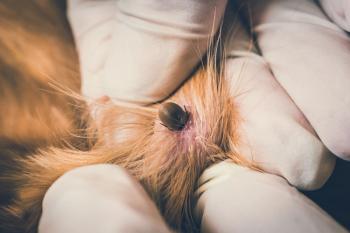
Differentiating rear limb lameness in dogs: hip or stifle (Proceedings)
History may be of help but be careful not to over interpret the description provided by the owner as it may be misleading. Often the owner may observe lameness in one limb when the condition is bilateral. With the latter, the dog will be lame in the limb that is more painful; however the lameness may shift from one side to the other.
History
History may be of help but be careful not to over interpret the description provided by the owner as it may be misleading. Often the owner may observe lameness in one limb when the condition is bilateral. With the latter, the dog will be lame in the limb that is more painful; however the lameness may shift from one side to the other. In the rear limb, unilateral lameness in the adult dog is commonly attributed to a problem in the stifle joint whereas a bilateral problem (difficulty rising, shifting weight to the front limbs) can be attributed to hip joints, stifle joints, or low back. A dog with an orthopedic problem will often "warm out" of an apparent lameness only to show discomfort again after resting. A dog with a neurologic problem is more likely to worsen and become weaker with activity. Also, be aware that the owner may describe the lameness to be present in the opposite normal limb since they are often looking at the dog from the front. When doing so, the owner's right side is the dog's left side and the owners left side is the dog's right side. In the forelimb, owners often misinterpret the sound limb as being the lame side; they perceive the head dropping downward as being a sign of lameness. Indeed the head drops down as the dog lands with more weight on the sound side.
Signalment
A correct diagnosis is paramount to optimal outcome and is dependent upon an accurate signalment, history, physical exam and diagnostic modalities. The signalment (breed, sex, age) is a simple but important consideration. Signalment is helpful for developing an accurate differential diagnosis. Many orthopedic diseases are predictable within certain age groups and breeds. For example, certain conditions are more prominent in small breeds relative to large breeds of dogs (Legg-Perthes Disease, Patella Luxation in small or large breeds; Hip Dysplasia, Cranial Cruciate Ligament injury in Larger Breeds). Age is likewise helpful in differentiating between conditions. In a dog with rear limb lameness, consider Hip Dysplasia in a young dog but Cranial Cruciate Ligament injury in a middle aged dog.
General examination techniques of the rear limb
Palpate the tarsal joints for fluctuant swelling indicative of joint effusion. This may be a subtle finding in the hock and is more easily noted when the animal is standing, because loading the joint forces the fluid peripherally. Firm swelling is suggestive of degenerative joint disease. Extend, adduct, and abduct the hock and metacarpal bones to demonstrate instability of the collateral ligaments. With the stifle in extension and the hock stressed into flexion, palpate the Achilles tendon. Extend and flex the stifle while holding one hand over the cranial aspect of the joint to detect crepitation. Next examine the stability of the patella in relationship to the femur. Extend the stifle, internally rotate the foot, and apply digital pressure in an attempt to displace the patella medially (i.e., medial patellar luxation).Detect lateral patellar luxation by slightly flexing the stifle, externally rotating the foot, and applying digital pressure to attempt to displace the patella laterally. The patella normally moves slightly medially and laterally, but when it leaves the trochlear groove it is considered to be luxating. Test the integrity of the collateral ligaments by holding the stifle in full extension and attempting to open the stifle on the medial and lateral aspects. Test the medial collateral ligament by using one hand to brace the femur while the other hand abducts the tibia. Normally the medial collateral ligament will not allow joint laxity. Test the lateral collateral ligament by bracing the femur with one hand and using the other hand to adduct the tibia. An intact lateral collateral ligament will prevent joint laxity. If the stifle is allowed to flex while the tibia is adducted, it may feel as though there is lateral laxity of the joint. This is a result of anatomic location of the lateral collateral ligament and internal rotation of the tibia and is normal.
Diagnostic methods for detection of CCL injury
Examination
Perform the initial examination of the stifle with the animal standing. Simultaneously palpate both stifles to detect swelling. A swollen stifle usually indicates degenerative joint disease. The patellar ligament becomes less distinct with joint effusion and the medial aspect of the stifle enlarges because of capsular thickening and osteophyte formation. Palpate the stability of the patella with the hip joint in full extension. Ask the animal to sit; observe the flexion of the stifle and tarsus. The earliest sign of stifle joint pathology is failure to dorsiflex the tarsus fully (compare to the opposite normal side).
As effusion and periarticular reaction progresses, the animal will no longer flex the stifle joint fully (compare to the opposite normal side).
The remainder of the examination is done with the animal in lateral recumbency. Extend and flex the stifle while holding one hand over the cranial aspect of the joint to detect crepitation. Next examine the stability of the patella in relationship to the femur. Extend the stifle, internally rotate the foot, and apply digital pressure in an attempt to displace the patella medially (i.e., medial patellar luxation).Detect lateral patellar luxation by slightly flexing the stifle, externally rotating the foot, and applying digital pressure to attempt to displace the patella laterally. The patella normally moves slightly medially and laterally, but when it leaves the trochlear groove it is considered to be luxating.
Collateral ligaments.
Test the integrity of the collateral ligaments by holding the stifle in full extension and attempting to open the stifle on the medial and lateral aspects. Test the medial collateral ligament by using one hand to brace the femur while the other hand abducts the tibia. Normally the medial collateral ligament will not allow joint laxity. Test the lateral collateral ligament by bracing the femur with one hand and using the other hand to adduct the tibia. An intact lateral collateral ligament will prevent joint laxity. If the stifle is allowed to flex while the tibia is adducted, it may feel as though there is lateral laxity of the joint. This is a result of anatomic location of the lateral collateral ligament and internal rotation of the tibia and is normal.
Cruciate ligaments.
Test the integrity of the cruciate ligaments by trying to elicit a cranial or caudal drawer motion. Drawer movement is caused by the tibia sliding cranially or caudally in relationship to the femur. This motion is not possible when the cruciate ligaments are intact in adult animals. Immature animals may have slight drawer motion, but it stops abruptly as the ligament tightens. To elicit direct drawer motion, place the index finger and thumb of one hand over the patella and lateral fabellar regions, respectively. Place the index finger of the opposite hand on the tibial tuberosity and, with the thumb positioned caudal to the fibular head, slightly flex the stifle. Stabilize the femur, and gently move the tibia cranial and distal to the femur. Do not allow tibial rotation. If the muscles are tense, they may prevent this motion. If this occurs, gently flex and extend the stifle to relax the animal, and repeat the procedure. Test drawer motion with the femur flexed and extended. Usually, the greatest movement is felt with the stifle in flexion. The presence and amount of drawer motion depend on the animal's age, size, state of relaxation, and the duration and type of cruciate pathology. There is minimal drawer motion in normal dogs and cats, although very young puppies may have a "lax" stifle. Eliciting drawer motion in larger animals or those that are tense is difficult; sedation or general anesthesia may be necessary. Minimal drawer motion may be noted with chronic cruciate pathology (especially in large dogs) because periarticular fibrosis restricts stifle motion. Minimal or partial drawer motion may also occur with incomplete tears or stretching of the cranial cruciate ligament. Drawer motion is evident with a torn caudal cruciate ligament. To identify caudal drawer motion, start with the stifle in a neutral position. Most caudal ligament ruptures are not discovered until exploration because they are mistaken for cranial ligament injuries.
Imaging
Early diagnosis is dependent upon radiographic presence of joint effusion. A radiolucent line adjacent to the caudal joint capsule is representative of fatty tissue in the space between the joint capsule and popliteal muscle. Caudal displacement of this line is representative of joint effusion. This is one of the earliest radiographic indications of partial anterior cruciate ligament injury. As changes progress, typical radiographic signs of DJD will be noted.
Newsletter
From exam room tips to practice management insights, get trusted veterinary news delivered straight to your inbox—subscribe to dvm360.




